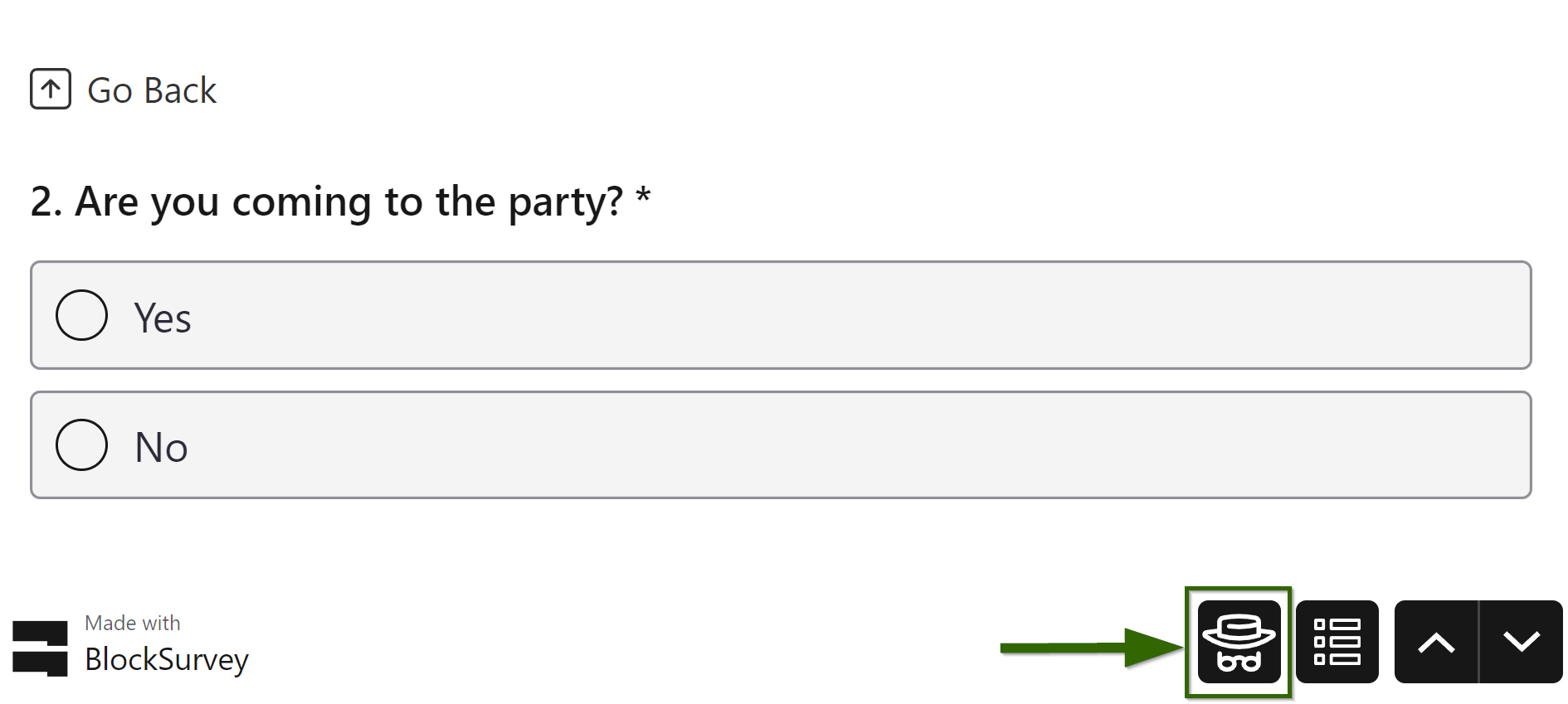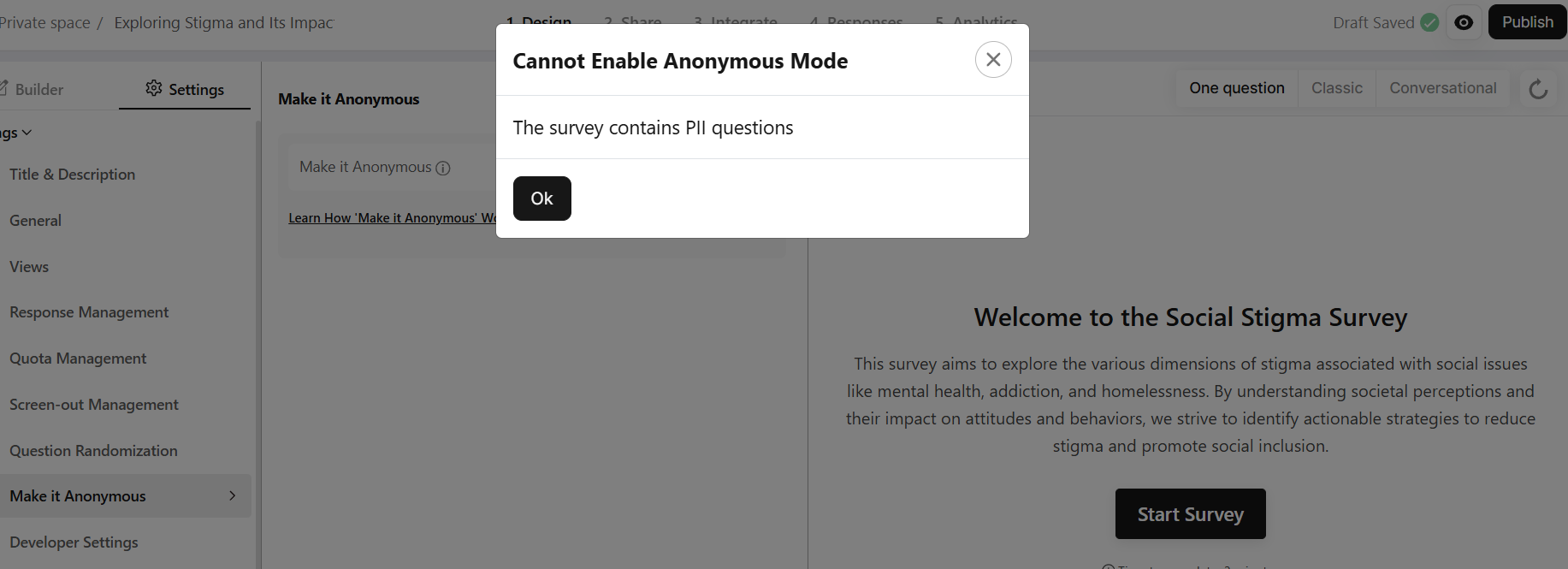Get insights.
Unlock value.
- 14-day free trial
- Set up in minutes
- No credit card required
How to Ask Sensitive Questions About Mental Health Stigma and Get Honest Answers: Strategies to break the silence
Is your mental health stigma research capturing the unfiltered truth? Or are your respondents holding back?
For researchers studying mental health stigma, the challenge is stark: How do you ask about deeply personal, culturally taboo experiences without alienating participants or skewing results?
You spend weeks or maybe months designing a mental health stigma survey. But when you receive the responses, you feel something is off. Mishandled questions can create distrust, bury the truth and makes you more difficult to uncover the stigma.
If your survey questions are unclear, biased, or too personal people may not answer honestly. Or they might skip the questions altogether. If your survey is too long or repetitive, survey fatigue kicks in - leading to rushed answers, drop-offs, and missing the insights you want.
The result? You get twisted data and fewer responses that fail to give you the meaningful insights you intended.
So how do you fix this? Let’s dive in.
The Consequences of Poor Survey Design
When your survey design fails to create a sense of safety and trust, your data becomes unreliable. Unreliable data leads to:
- Misinformation - you make half-baked decisions based on the shallow insights you got.
- Loss of credibility - your research loses credibility when the results don't meet the reality.
- Broken trust – If participants feel unsafe, they may never engage with your research again.
Even worse, if your survey itself feels uncomfortable or stigmatizing, you might unintentionally add barriers you're trying to break.
But how can you change that?
How to Design Mental health Stigma Surveys For Honest Answers
People won’t tell the truth if your survey makes them feel judged, unsafe, or bored. Here’s how to craft your questions about mental health stigma:
Ask Questions with Care
The way you phrase a question shapes the answer. If it feels pushy or judgmental, people might skip it or say what sounds “right” instead of what’s true.
Bad question: "Why haven’t you sought therapy for your mental health issues?"
What’s wrong? Assumes they have mental health issues and haven’t gotten help.
Better: "Have you ever considered therapy? If not, what factors influenced your decision?"
Why it works? It’s neutral and allows for honest, open-ended responses.
Use Open-Ended Questions Wisely
Open-ended questions give rich insights—but too many can feel like an exam. People get tired and stop answering.
Bad: Asking only open-ended questions, makes the survey exhausting.
Better: Use open-text fields after multiple-choice questions for extra details.
Example: "If you’ve hesitated to seek mental health support, what influenced your decision?"
Why it works? Let respondents share their experiences without pressure.
Make Anonymity Feel Real
People won’t open up if they think their answers can be traced back to them. Even if you promise confidentiality, trust matters. Without true anonymity responses may be filtered, incomplete, or skipped.
Bad: Asking for names, emails, or personal info that isn’t needed.
Better: Create anonymous surveys to get real insights. Use anonymous survey tool that don’t track IPs or metadata.
Tip: Clearly explain how responses will be stored and used. When people feel safe, they’ll be more honest.
Keep It Short & Engaging
Long, repetitive surveys lead to rushed answers or drop-offs. Nobody wants to spend 30 minutes filling out a boring form.
Bad: A 50-question survey with similar questions asked in different ways.
Better: Keep it under 15 minutes with a mix of question types.
Tip: Use a progress bar so respondents see how much is left - it keeps them motivated to finish.
Test Before You Launch
Even a well-designed survey can have blind spots. Testing helps catch confusing or awkward questions before they go live.
Bad: Sending the survey straight to your full audience without feedback.
Better: Test it with a small group first, then tweak based on their responses.
Tip: Ask test participants if any questions felt unclear or uncomfortable. Fix issues early for better data later.
If you want real, unfiltered answers, your survey must feel safe, stigma-free, and truly anonymous. That’s exactly why BlockSurvey exists. To help you collect true insights without hesitation.
How BlockSurvey Ensures Anonymity?
You know you are supporting anonymity but how would you communicate and make your participants trust your survey, the choice of tool you make must ensure them. BlockSurvey is one such absolutely anonymous survey tool that works on a privacy-first approach. Here are a few features that support complete anonymity and helps increase participation in your mental health stigma surveys.
- 100% Anonymous: Your surveys are fully end-to-end encrypted, with zero tracking of IPs, emails, or metadata - ensuring complete privacy.

And, when you enable the Anonymous Seal, an icon appears on your survey, reassuring participants that their responses are truly untraceable. When they feel safe, they answer honestly.
- Zero Knowledge Architecture: With Zero knowledge architecture, not even BlockSurvey can see the responses. All the responses are end-to-end encrypted using the private keys.
- PII Privacy Alerts: If your survey includes personally identifiable information (PII), BlockSurvey will warn you - and the anonymous feature won’t activate unless removed.
Even if you try to toggle it will pop up the below message.

Tip: Need help crafting a truly anonymous survey? Our AI-powered surveys can help you design questions that avoid PII, so you collect only the data that matters - without compromising privacy.
- Trustworthy & Affordable: Unlike traditional survey tools, we put privacy first without breaking your budget.
- Designed for Sensitive Topics: Ideal for mental health research, employee feedback, and any survey where truth matters more than data collection.
When people feel completely safe, they tell the truth.
That’s why researchers, psychologists, and businesses trust BlockSurvey to uncover deep insights without compromising privacy.
Try BlockSurvey today. Get honest answers, fear-free.
How to Ask Sensitive Questions About Mental Health Stigma and Get Honest Answers: Strategies to break the silence FAQ
Why do respondents skip sensitive questions in mental health stigma research surveys?
Respondents may skip sensitive questions if they feel judged, unsafe, or uncomfortable with how the question is framed. Unclear, biased, or overly personal questions can make participants hesitant to answer truthfully—or at all.
How does survey fatigue affect mental health stigma research?
Survey fatigue occurs when a survey is too long, repetitive, or exhausting, leading to rushed responses, drop-offs, or skipped questions. Keeping surveys concise (under 15 minutes), engaging, and well-structured helps prevent this.
How can I ensure my mental health stigma research survey is truly anonymous?
Using a zero-knowledge, end-to-end encrypted survey tool like BlockSurvey ensures no tracking of IPs, emails, or metadata. Plus, the Anonymous Seal reassures respondents that their answers are truly untraceable, encouraging honest participation.
How does BlockSurvey help prevent personally identifiable information (PII) in surveys?
BlockSurvey includes PII Privacy Alerts, which warn you if any question collects personal data. If PII is detected, the anonymous feature won’t activate unless the PII is removed—ensuring full anonymity and compliance with privacy standards.
Get insights.
Unlock value.
- 14-day free trial
- Set up in minutes
- No credit card required


